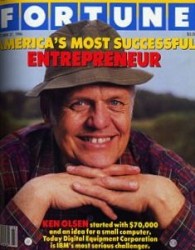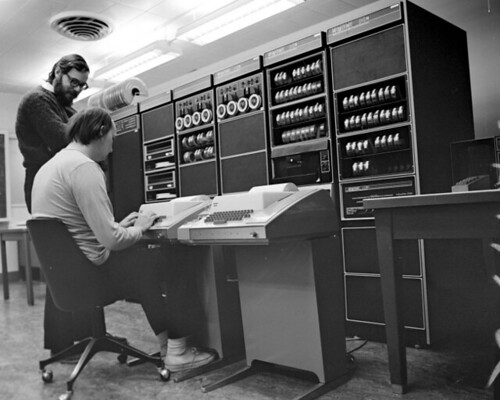Ken Olsen and his once-great company
Ken Olsen, co-founder of Digital Equipment Corporation, died Feb. 6. While most millennials would say “who?” those with a little more perspective will remember him as one of the most significant business leaders and entrepreneurs of 20th century computer history.
DEC invented the minicomputer, which provide the greatest access to computing and the greatest challenge to IBM’s System/360 hegemony until the arrival of the PC. As recounted by Tim Bresnahan and Shane Greenstein in their classic 1999 history of computing platforms, its VAX/VMS offered much of the power of the System 370 but without the up front and operating cost.
 Ken Olsen was thus labelled “America’s Most Successful Entrepreneur” in an October 1986 Fortune magazine cover story. He was the subject of the 1988 biography The Ultimate Entrepreneur.
Ken Olsen was thus labelled “America’s Most Successful Entrepreneur” in an October 1986 Fortune magazine cover story. He was the subject of the 1988 biography The Ultimate Entrepreneur.
The company also had a unique engineering-culture, which Ed Schein chronicled in his book DEC is Dead, Long Live DEC. To this day, the company still inspires a legion of loyal former customers, as this posting to The Register notes:
So, like many others on this and other threads I too owe a considerable debt to Digital Equipment Company. Although I have never worked for the company, the skills and attitudes have left me well positioned to meet many career challenges. Even today, working in an outsourcing business it is still fun to run through asset lists from contracts to see how many VAX and Alpha boxes are still running out there. It's far more than many people might expect.
As a onetime software engineer, I have nothing but fond memories of the VAX. Writing third party software for the VAX was my first job out of college, which provided the down payment on my first home. The OS had an elegant orthogonality which made a joy out of writing a compiler or mere shell scripts. (The Motorola 68000 architecture, also derived from DEC’s PDP-11, was a poor second.)
The DEC minicomputers also indirectly brought us Unix — as Ken Ritchie and Dennis Thompson wrote the operating system for the smaller DEC minicomputers, the PDP-7 and then the PDP-11. Berkeley created the great BSD distributions of Unix (leading to FreeBSD and OS X) on the PDP-11 and VAX.
The 1980s were the high water mark of the VAX and DEC’s minicomputer cash cow. The company had a nearly three decade run until undercut (ala Clay Christensen) by a combination of open systems and the PC.
Ken Olsen clearly never understood the significance of the PC, as his Smithsonian interview made clear. (I summarize key points in an obituary I wrote February 8 for my OpenITStrategies blog.) One source I didn’t have then was a 1995 Smithsonian interview with the original VAX architect Gordon Bell:
A year after the PC hit, it was so clear the game was over. And DEC never got it. They just didn’t get it. And I hate to say it, but anyone should have gotten it.
Still — as with the “disruptive innovation” that made Clay Christensen — there are lots of reasons why successful firms can’t see such low-end challengers.
And Olsen was hardly alone. I was cleaning up my office over the weekend and found two Upside magazine interviews with Olsen’s successor, Robert Palmer, who Wikipedia helpfully notes is “best known for his role as the last Chairman and Chief Executive Officer of Digital Equipment Corporation.” The interviews made clear that Palmer’s strategy in the mid-90s was no more coherent than the one that got Olsen ignominiously deposed in 1992, which is why the company was eventually bought by Compaq in 1998.
But IBM also underestimated the PC. One figure I heard Wednesday (after Steve Usselman’s talk at Stanford) was that IBM itself expected to only sell 300,000 PCs worldwide.
Still, IBM survived, reinventing itself as a global services and integration powerhouse. Except for NCR — master of ATMs and video kiosks — the rest of its 1960s rivals (the BUNCH) have disappeared into oblivion. In 1985, DEC accomplished single-handedly something the Seven Dwarfs had not, but a decade later it was on the verge of extinction.
The creators of Unix at a DEC PDP-11. Photo from Flickr.


